Reserve Bank of Australia Annual Report – 2020 Our People
The Reserve Bank seeks to attract, develop and retain high-quality people with the technical skills and capabilities to achieve the Bank's strategic objectives, and behaviours that are consistent with the Bank's values. A key focus of the Bank is to support a diverse and inclusive workforce that is reflective of all Australians.[1]
Our Values
The Reserve Bank's values, as set out in its Code of Conduct, help shape the Bank's culture and guide expectations and standards around workplace behaviour and professional conduct. The Bank's values are as follows.
1. Promotion of the public interest
We serve the public interest. We ensure that our efforts are directed to this objective, and not to serving our own interests or the interests of any other person or group.
2. Excellence
We strive for technical and professional excellence.
3. Intelligent inquiry
We think carefully about the work we do and how we undertake it. We encourage debate, ask questions and speak up when we have concerns.
4. Integrity
We are honest in our dealings with others within and outside the Bank. We are open and clear in our dealings with our colleagues. We take appropriate action if we are aware of others who are not acting properly.
5. Respect
We treat one another with respect and courtesy. We value one another's views and contributions.
2019/20 Workforce Profile
In June 2020, the Reserve Bank (excluding Note Printing Australia Limited) had 1,384 employees. With 8 per cent of employees working part time, the Bank's workforce comprised 1,348 full-time equivalent (FTE) employees. During the year, the Bank hired 200 employees, of whom 59 per cent were recruited into short-term, temporary positions.
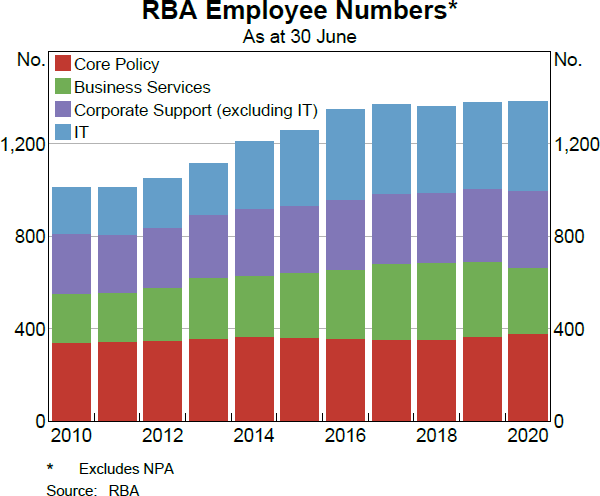
| 30 June 2020 | 30 June 2019 | |||||||||||||||||||||||||||||||||||||||||||||||||||||||||||||||||||||||||||||||||||||||||||||||||||||||||||||||||||||||||||||||||||||||||||
|---|---|---|---|---|---|---|---|---|---|---|---|---|---|---|---|---|---|---|---|---|---|---|---|---|---|---|---|---|---|---|---|---|---|---|---|---|---|---|---|---|---|---|---|---|---|---|---|---|---|---|---|---|---|---|---|---|---|---|---|---|---|---|---|---|---|---|---|---|---|---|---|---|---|---|---|---|---|---|---|---|---|---|---|---|---|---|---|---|---|---|---|---|---|---|---|---|---|---|---|---|---|---|---|---|---|---|---|---|---|---|---|---|---|---|---|---|---|---|---|---|---|---|---|---|---|---|---|---|---|---|---|---|---|---|---|---|---|---|---|---|
| Work practices | ||||||||||||||||||||||||||||||||||||||||||||||||||||||||||||||||||||||||||||||||||||||||||||||||||||||||||||||||||||||||||||||||||||||||||||
| – Full time | 1,273 | 1,268 | ||||||||||||||||||||||||||||||||||||||||||||||||||||||||||||||||||||||||||||||||||||||||||||||||||||||||||||||||||||||||||||||||||||||||||
| – Part time | 111 | 110 | ||||||||||||||||||||||||||||||||||||||||||||||||||||||||||||||||||||||||||||||||||||||||||||||||||||||||||||||||||||||||||||||||||||||||||
| Gender | ||||||||||||||||||||||||||||||||||||||||||||||||||||||||||||||||||||||||||||||||||||||||||||||||||||||||||||||||||||||||||||||||||||||||||||
| – Women | 599 | 600 | ||||||||||||||||||||||||||||||||||||||||||||||||||||||||||||||||||||||||||||||||||||||||||||||||||||||||||||||||||||||||||||||||||||||||||
| – Men | 785 | 778 | ||||||||||||||||||||||||||||||||||||||||||||||||||||||||||||||||||||||||||||||||||||||||||||||||||||||||||||||||||||||||||||||||||||||||||
| Location | ||||||||||||||||||||||||||||||||||||||||||||||||||||||||||||||||||||||||||||||||||||||||||||||||||||||||||||||||||||||||||||||||||||||||||||
| – Head Office, Sydney | 1,225 | 1,221 | ||||||||||||||||||||||||||||||||||||||||||||||||||||||||||||||||||||||||||||||||||||||||||||||||||||||||||||||||||||||||||||||||||||||||||
| – H. C. Coombs Centre for Financial Studies, Sydney | 2 | 2 | ||||||||||||||||||||||||||||||||||||||||||||||||||||||||||||||||||||||||||||||||||||||||||||||||||||||||||||||||||||||||||||||||||||||||||
| – Business Resumption Site, Sydney | 39 | 41 | ||||||||||||||||||||||||||||||||||||||||||||||||||||||||||||||||||||||||||||||||||||||||||||||||||||||||||||||||||||||||||||||||||||||||||
| – Note-printing facility and National Banknote Site, Craigieburn | 69 | 69 | ||||||||||||||||||||||||||||||||||||||||||||||||||||||||||||||||||||||||||||||||||||||||||||||||||||||||||||||||||||||||||||||||||||||||||
| – Canberra Branch | 13 | 12 | ||||||||||||||||||||||||||||||||||||||||||||||||||||||||||||||||||||||||||||||||||||||||||||||||||||||||||||||||||||||||||||||||||||||||||
| – Victorian Office, Melbourne | 4 | 4 | ||||||||||||||||||||||||||||||||||||||||||||||||||||||||||||||||||||||||||||||||||||||||||||||||||||||||||||||||||||||||||||||||||||||||||
| – Queensland Office, Brisbane | 5 | 3 | ||||||||||||||||||||||||||||||||||||||||||||||||||||||||||||||||||||||||||||||||||||||||||||||||||||||||||||||||||||||||||||||||||||||||||
| – South Australian Office, Adelaide | 3 | 3 | ||||||||||||||||||||||||||||||||||||||||||||||||||||||||||||||||||||||||||||||||||||||||||||||||||||||||||||||||||||||||||||||||||||||||||
| – Western Australian Office, Perth | 4 | 3 | ||||||||||||||||||||||||||||||||||||||||||||||||||||||||||||||||||||||||||||||||||||||||||||||||||||||||||||||||||||||||||||||||||||||||||
| – New York Representative Office | 9 | 9 | ||||||||||||||||||||||||||||||||||||||||||||||||||||||||||||||||||||||||||||||||||||||||||||||||||||||||||||||||||||||||||||||||||||||||||
| – European Representative Office, London | 8 | 8 | ||||||||||||||||||||||||||||||||||||||||||||||||||||||||||||||||||||||||||||||||||||||||||||||||||||||||||||||||||||||||||||||||||||||||||
| – China Representative Office, Beijing | 3 | 3 | ||||||||||||||||||||||||||||||||||||||||||||||||||||||||||||||||||||||||||||||||||||||||||||||||||||||||||||||||||||||||||||||||||||||||||
| Total | 1,384 | 1,378 | ||||||||||||||||||||||||||||||||||||||||||||||||||||||||||||||||||||||||||||||||||||||||||||||||||||||||||||||||||||||||||||||||||||||||||
Source: RBA |
||||||||||||||||||||||||||||||||||||||||||||||||||||||||||||||||||||||||||||||||||||||||||||||||||||||||||||||||||||||||||||||||||||||||||||
The Reserve Bank is committed to achieving gender equity. Women account for 43.3 per cent of the Bank's employees, comparable to the Australia-wide share of employment of 47 per cent.
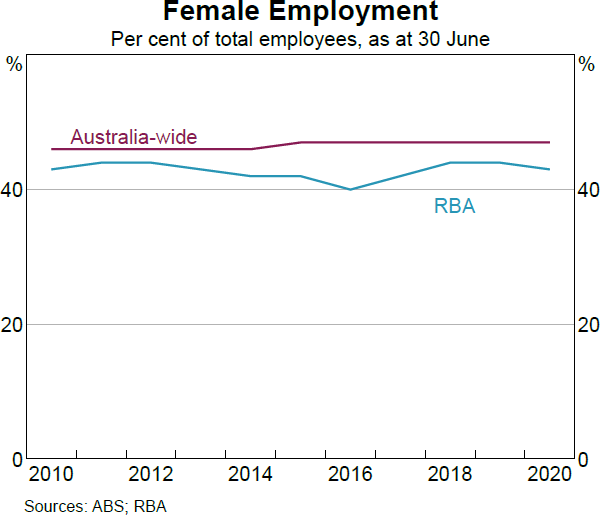
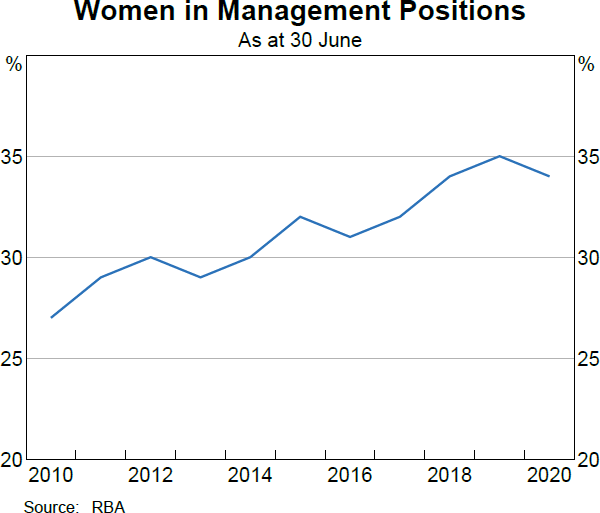
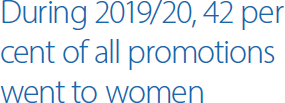
The Bank's longer-term objective is to achieve equal representation of women in management positions. To achieve this, a key focus is equity in recruitment and selection, succession planning and development opportunities. During 2019/20, 42 per cent of all promotions went to women. Of the 38 employees promoted to management positions, 37 per cent were women. The Bank's current target of 35 per cent women in management positions was achieved in 2019. In 2020, 34 per cent of women held management positions.
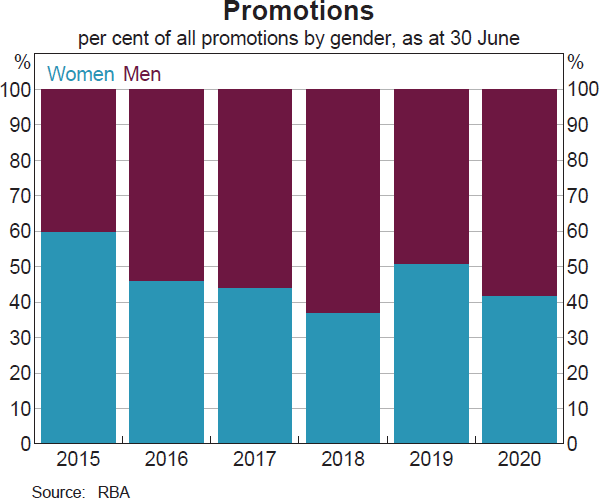
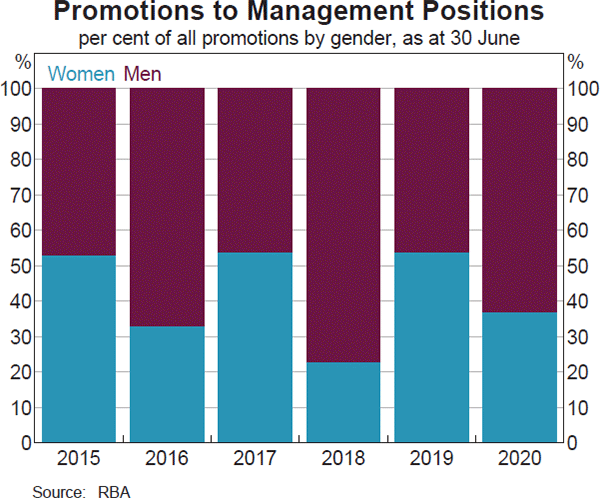


Recruitment and Development
The ability to attract high-quality people is essential to the Reserve Bank achieving its strategic objectives. Ensuring that the Bank is seen as an employer of choice and establishing strong recruitment practices and processes based on the principles of transparency, non-discrimination and merit are key elements to achieving this.
The Bank has a well-established, two-year Graduate Development Program. In this program, graduates are provided with structured development opportunities through a balance of on-the-job training, rotations between key departments and structured development activities. From the 706 applications, 32 graduates started the program in 2020, compared with 30 graduates a year earlier.
The Bank also offers an eight-week Internship Program, which provides high-performing university students with work experience and training through the completion of an applied research project. From over 460 applications, 25 places were offered in the 2020 program. To ensure fair and equal assessment of all applicants from across Australia in response to the COVID-19 pandemic, a video interviewing capability was introduced.
The Bank encourages employees to develop their skills continually. This involves providing access to a range of online training tools and regular knowledge-sharing sessions. The Bank also provides financial support to employees for full-time and part-time study in disciplines related to their work including economics, finance, business administration, accounting and information technologies. During 2019/20, the Bank provided support to 34 employees undertaking part-time study and provided support to eight employees undertaking full-time postgraduate study at universities in Australia and overseas.
Rotations and secondments
In partnership with other Australian and international institutions, secondment opportunities are offered to Reserve Bank employees to provide different experiences, assist with capability development and share subject matter expertise and best practice. During 2019/20, these secondment opportunities involved the Australian Prudential Regulatory Authority, the Australian Treasury, the Australian Bureau of Statistics, the Australian Securities and Investment Commission and the Australian Competition and Consumer Commission, as well as a range of international institutions, including the Bank for International Settlements, the International Monetary Fund, the Bank of England, the Bank of France and the Reserve Bank of New Zealand.
Employee Engagement
The Reserve Bank's biennial employee engagement survey was run in 2019, with an 83 per cent participation rate. The survey revealed that the Bank's employees have high sustainable engagement compared with external benchmarks. The results highlighted that our employees are strongly connected to the Bank's purpose and values, that the Bank has a collaborative culture and acknowledged that the Bank is supportive of their mental health and wellbeing. The survey also identified areas for improvement, including the need for improved career and development opportunities, and highlighted the different perspectives of leadership effectiveness across the Bank. These issues will be addressed with the introduction of a new Job Family and Career Development framework and an enterprise-wide Leadership Development Strategy.
Diversity and Inclusion
The People and Culture Strategy actively promotes an inclusive work environment. During 2019/20, the Reserve Bank's Diversity and Inclusion Council and Employee Resource Groups (ERGs) continued to pursue activities and practices supporting the Bank's Diversity and Inclusion Plan, underpinned by a Statement of Commitment.
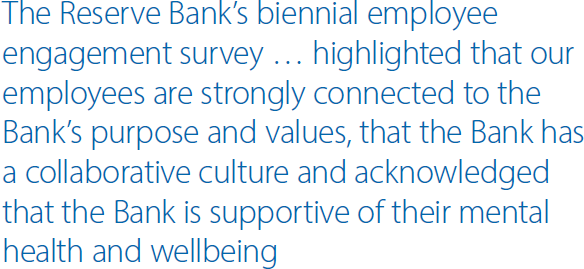
Statement of Commitment
The Reserve Bank's Diversity and Inclusion Statement of Commitment outlines our commitment to:
- providing equal employment opportunities for all current and prospective employees, based on their abilities and performance
- fostering the inclusion of women, various age groups, people with disabilities, people of diverse cultural backgrounds, Indigenous Australians and LGBTI (lesbian, gay, bisexual, transgender and intersex) employees within our workplace
- developing a deep and diverse pool of well-trained potential leaders in order to increase the diversity of people who hold management positions. The Bank has a gender diversity target for 35 per cent of management roles to be held by women by 2020 and 50 per cent in the longer term
- promoting an inclusive and collaborative culture by ensuring employees are treated fairly and equitably in line with the Bank's values
- equitably enacting and applying the Bank's policies, including those in relation to workplace conduct, leave, flexible work management, remuneration, recruitment and selection.
The Bank's Diversity and Inclusion Program is overseen by the Executive Committee, in consultation with the Diversity and Inclusion Council, which is responsible for monitoring the development and implementation of diversity and inclusion initiatives, policies and practices in the Bank.
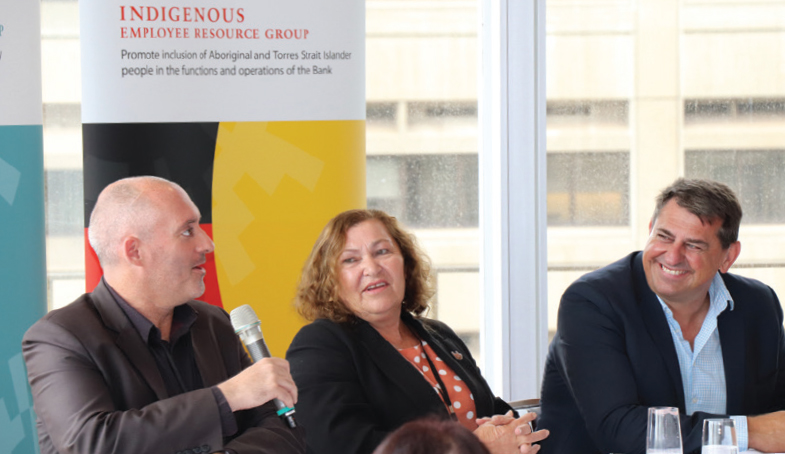

Diversity and Inclusion Council
The Diversity and Inclusion Council meets quarterly and is chaired by the Deputy Governor. The Council comprises the Head of Human Resources and the sponsors and chairs of the six Employee Resource Groups (ERGs), which focus on issues of diversity and inclusion in six specific areas: Accessibility, Flexibility, Gender Equity, Indigenous Australians, LGBTI+Allies, and Race and Cultural Identity. Participation in the ERGs is voluntary and over 200 employees are members or associate members of the groups.
In addition to a number of activities designed to increase employee awareness, the Council, in conjunction with the ERGs, promoted a number of important diversity and inclusion initiatives:
- An Accessibility Action Plan was launch in May 2020 as part of Global Accessibility Awareness Day. This two-year Plan outlines the Reserve Bank's commitment towards enhancing accessibility and to reach an aspiration goal of establishing the Bank as a disability employer of choice.
- Participation in the Dr John Yu Fellowship Program on Cultural Diversity and Leadership to invest in culturally diverse leaders and collaborate with other government agencies to share experiences and work together to create a more supportive and inclusive work environment.
- The Bank achieved its commitments outlined in the 2018 Reflect Reconciliation Action Plan. This plan provided the Bank with a strong foundation and framework to engage in the process of reconciliation with Indigenous Australians, and will be continued by the 2020 Innovate Reconciliation Action Plan.
Aboriginal and Torres Strait Islander employment was a key objective of the Bank's Reconciliation Action Plan (RAP). The Bank continues to partner with My Gateway, an apprenticeship and traineeship support organisation. Two trainees from the 2019 cohort graduated with a Certificate III in Business Administration, and have continued in extended traineeships with the Bank. Four new trainees joined the Bank in 2020 to complete a 12-month traineeship. The Bank also provided five students with internships as part of its continuing partnership with CareerTrackers, a non-profit agency supporting organisations to provide work experience for Indigenous Australian university students.
Work Health and Safety, Compensation and Rehabilitation
The Reserve Bank is committed to maintaining and improving the safety, health and wellbeing of its employees. The Reserve Bank Board and the Bank's executives receive regular reports on WHS matters to assist them in exercising their duty of care.
During the year, areas of strategic focus included:
- establishment of evidence-based programs designed to encourage positive behavioural changes to employees' physical, social, and mental health and wellbeing
- the Mental Health and Wellbeing Strategic Plan remained an ongoing initiative, with an emphasis on developing people leadership capability, mental health awareness and peer support
- identification and implementation of a range of initiatives to enhance the Bank's safety culture and consistency in approach to management
- implementation of a range of workplace safety and wellbeing initiatives to respond to the COVID-19 pandemic.
The Reserve Bank continued to implement initiatives to maximise the physical and psychological health of employees, through promotion of positive health outcomes and prevention of potential health risks, including:
- encouraging staff to take two-week blocks of leave
- physical health activities, such as discounted rates at several fitness centres, conducting fitness classes and a nutrition program in Head Office, an annual health challenge, influenza vaccinations and installing a temporary health station to provide employees with baseline health information
- mental health initiatives, such as mental health supportive leadership training, access to the Bank's Employee Assistance Program, and seminars on topics related to mental health and wellbeing
- launching a Domestic and Family Violence Guideline to support employees.
There were 80 WHS incidents reported in 2019/20, 5 per cent fewer than in the previous year. The most common cause of incidents were people slipping/tripping/falling (16 per cent), people bumping or striking objects (14 per cent) and workplace factors such as chemical odour in strongrooms and electrical hazards (14 per cent).
There was one accepted workers' compensation claim in 2019/20, which related to a workplace injury. The Reserve Bank's Lost Time Injury Frequency Rate (number of lost time injuries per million hours worked) decreased in 2019/20 to 0.4 from 1.8 in the previous year.
Nine internal WHS investigations were conducted in 2019/20, relating to incidents that either caused moderate harm or had the potential to cause harm to a staff member. The investigations indicated that there were no systemic issues that would point to deficiencies in the way the Bank manages health and safety.
One investigation was made into the Bank's businesses or undertakings by Comcare during 2019/20, but no improvement, prohibition or non-disturbance notices were issued by Comcare under Part 10 of the Work Health and Safety Act 2011 (WHS Act).
The Reserve Bank is a Licensed Authority under the Safety, Rehabilitation and Compensation Act 1988. This licence requires the Bank to report to the Safety, Rehabilitation and Compensation Commission each year on WHS and workers' compensation and rehabilitation matters as they affect the Bank. Compliance with the relevant legislation – and the conditions of the Bank's licence as a Licensed Authority – was validated during the period by external audits of the Bank's safety, compensation and rehabilitation arrangements. The Safety, Rehabilitation and Compensation Commission subsequently confirmed that the Bank retained the highest rating for its prevention, claims management and rehabilitation practices in each area for 2019/20.
In 2019/20, the Australian Postal Corporation provided claims management and rehabilitation services to the Bank, along with reconsideration services and representation in the Administrative Appeals Tribunal or Federal Court, when necessary.
Employment Arrangements and Remuneration
The positions of Governor and Deputy Governor are designated as Principal Executive Offices in terms of the Remuneration Tribunal Act 1973, which provides for the Remuneration Tribunal to determine the applicable remuneration for these positions. Within the parameters determined by the Remuneration Tribunal, the Reserve Bank Board Remuneration Committee, comprising three non-executive members, makes a recommendation on remuneration for these positions for approval of the Reserve Bank Board, which is the ‘employing body’ for the positions. In accordance with provisions of the Reserve Bank Act 1959, neither the Governor nor the Deputy Governor takes part in decisions of the Reserve Bank Board relating to the determination or application of any terms or conditions on which either of them holds office.
| Action | 2019/20 | 2018/19 |
|---|---|---|
| Death of a person that required notice to Comcare under section 35 | 0 | 0 |
| Serious injury or illness of a person that required notice to Comcare under section 35 | 0 | 0 |
| Dangerous incident that required notice to Comcare under section 35 | 1 | 3 |
| Internal investigations conducted | 9 | 6 |
| Investigations conducted under Part 10 of the WHS Act | 0 | 0 |
| Notices given to RBA under section 90 (provisional improvement notices) | 0 | 0 |
| Notices given to RBA under section 191 (improvement notices) | 0 | 0 |
| Notices given to RBA under section 195 (prohibition notices) | 0 | 0 |
| Directions given to RBA under section 198 (non-disturbance notices) | 0 | 0 |
|
Source: RBA |
||
The employment arrangements that apply to Reserve Bank employees vary according to their occupation and level of seniority. Executive and managerial employees are engaged with the Reserve Bank under Individual Employment Agreements. Non-managerial employees are covered by the Bank's Workplace Agreement, although the majority of these employees also have Individual Employment Agreements. The existing Workplace Agreement nominally expired at the end of March 2020 and the Bank agreed to an approach to remuneration increases for the 2019/20 remuneration review and committed to return to workplace bargaining in 2021. The Bank and the Finance Sector Union of Australia identified the opportunity to work together towards a new modern, more flexible agreement. In the interim, all conditions contained in the existing agreement would continue to apply.
While the specific remuneration arrangements that apply to employees differ according to their employment arrangements with the Reserve Bank, remuneration packages are designed to attract and engage high-calibre employees. The Bank uses surveys such as Financial Institution Remuneration Group and Aon Hewitt for remuneration and benefit benchmarking.
As part of the annual review of remuneration, the Bank monitors differences in the salaries paid to men and women. While the gap between the average full-time equivalent salaries of men and women has declined since 2016, it did not decline during 2019. The gap continued to be explained largely by the fact that women occupy a greater proportion of positions at lower levels and a lower proportion of senior positions compared with men. The Bank has made progress on changing the gender composition of staff across levels and the higher composition of women in management roles helps to continue close the pay gap.
Given the difficult circumstances facing the country in the context of the COVID-19 pandemic, the Bank determined that it would not be appropriate to continue with pay increases on the same schedule as previous years in the 2019/20 remuneration review. While conditions of employment at the Bank are determined by the Governor, it was decided that it was appropriate to follow government guidelines regarding remuneration in the public sector during the pandemic.
For all staff in senior management positions, there were no general salary increases, career increments or performance payments for 2019/20. The general salary increases of 2 per cent for employees below senior management were deferred until March 2021, rather than being paid in September 2020. Lump-sum performance payments and career increment based increases were paid in September 2020, consistent with government guidelines.
The distribution of remuneration paid to Reserve Bank executives and other senior employees on an accrual basis is set out in the tables below. Bonuses paid to senior managers were made in September 2019, based on their performance in 2018/19. The provision of this information is consistent with similar information provided by other Commonwealth entities.
| Name | Position Title | Short-term Benefits | Post-employment Benefits | Other Long-term Benefits | Termination Benefits | Total Remuneration5,6 | |||
|---|---|---|---|---|---|---|---|---|---|
| Base Salary1 | Bonuses | Other Benefits and Allowances2 | Superannuation Contributions3 | Long Service Leave4 | Other Long-term Benefits | ||||
| Reserve Bank Executives | |||||||||
| Philip Lowe | Governor | 933,409 | – | 8,500 | 120,219 | 23,335 | – | – | 1,085,463 |
| Guy Debelle | Deputy Governor | 708,671 | – | 8,500 | 90,165 | 23,264 | – | – | 830,600 |
| Lindsay Boulton | Assistant Governor, Business Services | 478,451 | 9,166 | 37,507 | 86,716 | 11,686 | – | – | 623,526 |
| Susan Woods | Assistant Governor, Corporate Services | 504,643 | 9,166 | 37,507 | 79,196 | 11,957 | – | – | 642,469 |
| Luci Ellis | Assistant Governor, Economic | 469,456 | 9,166 | 37,507 | 86,716 | 15,582 | – | – | 618,427 |
| Christopher Kent | Assistant Governor, Financial Markets | 537,209 | 10,148 | 36,952 | 96,643 | 17,366 | – | – | 698,318 |
| Michele Bullock | Assistant Governor, Financial System | 530,604 | 10,339 | 37,507 | 97,812 | 16,217 | – | – | 692,479 |
| Non-Executive Members of the Reserve Bank Board | |||||||||
| Mark Barnaba | Member – Reserve Bank Board | 77,833 | – | – | 3,717 | – | – | – | 81,550 |
| Chair – Reserve Bank Board Audit Committee | 22,492 | – | – | 1,074 | – | – | – | 23,566 | |
| Wendy Craik | Member – Reserve Bank Board | 77,833 | – | – | 7,394 | – | – | 85,227 | |
| Philip Gaetjens | Member – Reserve Bank Board(b),(d) | – | – | – | – | – | – | – | – |
| Ian Harper | Member – Reserve Bank Board | 77,833 | – | – | 7,394 | – | – | – | 85,227 |
| Steven Kennedy | Member – Reserve Bank Board(c),(d) | – | – | – | – | – | – | – | – |
| Allan Moss | Member – Reserve Bank Board | 77,833 | – | – | 7,394 | – | – | – | 85,227 |
| Member – Reserve Bank Board Audit Committee | 11,251 | – | – | 1,069 | – | – | – | 12,320 | |
| Carol Schwartz | Member – Reserve Bank Board | 77,833 | – | – | 7,394 | – | – | – | 85,227 |
| Catherine Tanna | Member – Reserve Bank Board | 77,833 | – | – | 7,394 | – | – | – | 85,227 |
| Non-Executive Members of the Payments System Board | |||||||||
| Wayne Byres | Member – Payments System Board(d) | – | – | – | – | – | – | – | – |
| Gina Cass-Gottlieb | Member – Payments System Board | 61,147 | – | – | 5,809 | – | – | – | 66,956 |
| Deborah Ralston | Member – Payments System Board | 61,147 | – | – | 5,809 | – | – | – | 66,956 |
| Greg Storey | Member – Payments System Board | 61,147 | – | – | 5,809 | – | – | – | 66,956 |
| Catherine Walter | Member – Payments System Board | 61,147 | – | – | 5,809 | – | – | – | 66,956 |
| Brian Wilson | Member – Payments System Board | 61,147 | – | – | 5,809 | – | – | – | 66,956 |
| External Appointments to the Reserve Bank Board Audit Committee(e) | |||||||||
| Sandra Birkensleigh | Member – Reserve Bank Board Audit Committee | 11,251 | – | – | 1,069 | – | – | – | 12,320 |
| Rahoul Chowdry | Member – Reserve Bank Board Audit Committee | 11,251 | – | – | 1,069 | – | – | – | 12,320 |
Notes
|
|||||||||
| Total Remuneration Bands | Number of Senior Executives | Short-term Benefits | Post-employment Benefits | Other Long-term Benefits | Termination Benefits Average Termination Benefits |
Total Remuneration Average Total Remuneration |
|||
|---|---|---|---|---|---|---|---|---|---|
| Average Base Salary1 | Average Bonuses | Average Other Benefits and Allowances2 | Average Superannuation Contributions3 | Average Long Service Leave4 | Average Other Long-term Benefits | ||||
| $0 to $220,000 | 1 | 87,689 | – | 11,656 | 15,251 | 2,503 | – | – | 117,099 |
| $220,001 to $245,000 | 1 | 165,015 | – | 23,586 | 29,102 | 3,942 | – | – | 221,645 |
| $270,001 to $295,000 | 2 | 209,953 | 4,140 | 21,666 | 39,590 | 5,573 | – | – | 280,922 |
| $295,001 to $320,000 | 1 | 225,601 | 4,441 | 35,759 | 42,853 | 5,772 | – | – | 314,426 |
| $320,001 to $345,000 | 5 | 241,827 | 5,054 | 34,369 | 45,364 | 6,577 | – | – | 333,191 |
| $345,001 to $370,000 | 3 | 267,437 | 3,551 | 35,759 | 46,313 | 7,131 | – | – | 360,191 |
| $370,001 to $395,000 | 7 | 281,996 | 5,175 | 35,657 | 51,574 | 8,598 | – | – | 383,000 |
| $395,001 to $420,000 | 5 | 294,192 | 13,704 | 35,548 | 53,551 | 8,189 | – | – | 405,184 |
| $420,001 to $445,000 | 2 | 338,452 | 6,657 | 31,111 | 48,322 | 8,394 | – | – | 432,936 |
| $445,001 to $470,000 | 5 | 296,474 | 5,230 | 30,754 | 54,903 | 9,666 | – | 55,770 | 452,797 |
| $470,001 to $495,000 | 1 | 373,274 | 9,760 | 35,759 | 60,050 | 9,050 | – | – | 487,893 |
| $495,001 to $520,000 | 1 | 378,757 | 7,314 | 35,759 | 69,506 | 9,367 | – | – | 500,703 |
| $520,001 to $545,000 | 5 | 371,612 | 7,508 | 73,224 | 68,407 | 11,531 | – | – | 532,282 |
| $545,001 to $570,000 | 2 | 427,859 | 8,492 | 30,893 | 78,598 | 12,320 | – | – | 558,162 |
| $595,001 to $620,000 | 2 | 416,382 | 4,531 | 98,488 | 77,568 | 12,016 | – | – | 608,985 |
| $795,001 to $820,000 | 1 | 303,405 | 5,626 | 441,784 | 50,693 | 6,832 | – | – | 808,340 |
| $1,170,001 to $1,195,000 | 1 | 276,142 | 6,189 | 839,072 | 49,818 | 6,710 | – | – | 1,177,931 |
Notes
|
|||||||||
| Total Remuneration Bands | Number of Other Highly Paid Staff |
Short-term Benefits | Post-employment Benefits | Other Long-term Benefits | Termination Benefits Average Termination Benefits | Total Remuneration Average Total Remuneration |
|||
|---|---|---|---|---|---|---|---|---|---|
| Average Base Salary1 | Average Bonuses | Average Other Benefits and Allowances2 | Average Superannuation Contributions3 | Average Long Service Leave4 | Average Other Long-term Benefits | ||||
| $225,001 to $245,000 | 44 | 168,902 | 4,156 | 18,084 | 30,612 | 4,373 | – | 8,836 | 234,963 |
| $245,001 to $270,000 | 42 | 178,064 | 3,665 | 18,130 | 34,239 | 4,711 | – | 17,568 | 256,377 |
| $270,001 to $295,000 | 27 | 211,855 | 3,951 | 20,038 | 38,269 | 5,804 | – | – | 279,917 |
| $295,001 to $320,000 | 12 | 220,564 | 4,158 | 34,114 | 39,193 | 5,929 | – | – | 303,958 |
| $320,001 to $345,000 | 8 | 196,027 | 3,851 | 67,496 | 34,563 | 4,730 | – | 28,397 | 335,064 |
| $345,001 to $370,000 | 3 | 169,198 | 3,721 | 121,436 | 64,055 | 2,303 | – | – | 360,713 |
| $370,001 to $395,000 | 4 | 155,869 | 2,577 | 115,738 | 25,988 | 3,679 | – | 81,908 | 385,759 |
| $395,001 to $420,000 | 1 | 102,568 | 2,090 | 285,133 | 18,420 | 2,481 | – | – | 410,692 |
| $445,001 to $470,000 | 1 | 119,190 | 2,191 | 311,050 | 21,253 | 3,196 | – | – | 456,880 |
| $470,001 to $495,000 | 1 | 163,725 | 3,209 | 282,158 | 30,362 | 5,456 | – | – | 484,910 |
| $570,001 to $595,000 | 1 | 196,679 | 4,620 | 336,901 | 33,637 | 4,529 | – | – | 576,366 |
| $795,001 to $820,000 | 1 | 196,945 | 4,429 | 558,106 | 34,211 | 4,609 | – | – | 798,300 |
Notes
|
|||||||||
Footnote
This section of the Annual Report constitutes the Reserve Bank's program report for the purposes of section 9 of the Equal Employment Opportunity (Commonwealth Authorities) Act 1987. [1]